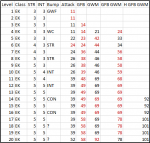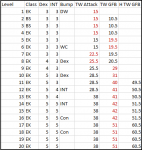I've been thinking about the blue rating given to bladesinger as a 2 level dip for EK... I don't think I value it so highly in my mind. Here are some DPR maths I did for a few EK/BS combos.
First a Fighter 1 / Bladesinger 19, named Alexander.
This Singer dipped Fighter at first level for TWF style, con saves, and some bonus HP. He takes dual wielder at 1 as a human, warcaster at 4, and ASI the rest of his levels.
He has two rapiers. As shown in red, he alternates between standard two weapon attacks and green flame blade depending on level and number/toughness of baddies. Haste is his jam once he picks it up and can use the haste attack to proc his TW attack. This in combo with his bonus INT to damage gives him melee DPR previously unknown to Wizard kind. He's one level shy of pure Wizard... so he has many spell slots to burn on Haste, shield, and other buff spells, while still maintaining decent battlefield control.
Alexander feels like a sword swinging melee magic god.

Next, a pure EK, named Brutus.
He takes great weapon master at 1, warcaster at 4, and loads up on ASI's later.
He's a greatsword user, becasue he's all about DPR. Once he gets green flame blade and/or booming blade he rarely looks back. Great weapon master is always an option. He can't cast a tonne of spells... But he's mostly here to abuse the new cantrips in a move for DPR king.
Brutus feels like an arcane engine of pure annihilation.

Finally, here's our EK 18 / BS 2, named George.
He dipped BS after his first fighter level. He did this because TWF seemed impractical without the new cantrips, but he loved how cool he looked with double rapiers. He did this because adding INT to his AC seemed like a better long-term plan than stumbling across magical armor. He did this to get spells like Haste just a little bit sooner.
He also uses two rapiers. His EK levels eventually give him a bonus attack when he uses the new cantrips, which is cool. He doesn't get haste for a while, but it's fun when he does. He only gets one more attack with haste, since his EK bonus attack uses the BA TWF needs. He has a few more spells than the pure EK, but not many, and he never reached high level spells.
George feels sad when he sees Alexander output more DPR and spells than him. George feels sad when he sees Brutus output way more DPR than him. George has better AC than Brutus, and better HP than Alexander, but he just isn't feeling great about himself. George spends a lot of time in therapy.

My feelings are hinted at above... but I guess I just don't see the reason you'd land in the middle with George.
-Alexander is doing more DPR once he has Haste, and has virtually full spell casting. Sure Alexander is lacking some HP, but he is going to burn spell slots on shield, mirror image, and blur all the time, with way more spell slots to do so than George.
-Brutus is a DPR champ... He's just going to chill up there in his Plate with his giant sword, abusing the new cantrips in horrible ways... throw in GWM and Haste and his damage output is disgusting. And he gets nearly as many spells as George...
I guess my feelings are that George is just Green, and Alexander might deserve some Blue love.
I haven't evaluated BS as an AT rogue dip, but on the surface it makes much more sense. They're naturally a DEX based class, can abuse Haste to the same degree as a pure BS, and benefit hugely since they don't get a normal extra attack. I can easily imagine them deserving the Blue rating.







